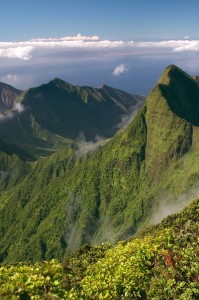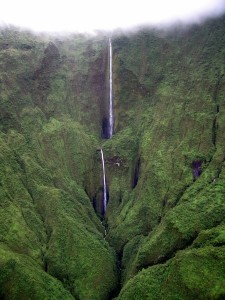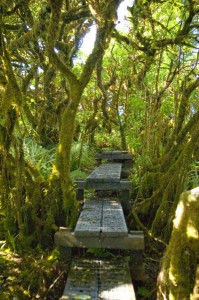
As I prepare for the upcoming Golf Road Warriors trip to Maui I’ve been looking back fondly on previous trips to Hawaii’s Magic Isle. On a journey there some years ago I wrote the following story for Backpacker Magazine. It depicts one of my fondest travel memories– an opportunity to hike in a place where very few humans had ever stepped before.
This story was first published in 2009. For current information on Pu’u Kukui and possible access to it, visit the Maui Land and Pineapple Company and the Hawaiian Islands Land Trust. Kapalua resort also maintains several hiking trails nearby, visit here for more information.
As a laughably strong wind blew me off the narrow boardwalk above First Bog in Pu’u Kukui Preserve I sank calf deep into black mud. Some experts estimate that each foot of bog here represents about 10,000 years of vegetative growth, so I had just stepped back—literally— into prehistory. Which seemed appropriate in this eerie landscape reminiscent of something out of Jurassic Park. And given that barely any humans have had the opportunity to walk in Pu’u Kukui, mine might have been the first calf to come in contact with this particular chilled soup of peat and rainwater.
If you’re the sort of person who’d like to attempt what may be the least-traveled day hike on the planet, don’t worry about visiting Bhutan or Ulan Bator. Just book a flight to the Hawaiian Island of Maui. And start saving your money. And buy a pair of knee-high rubber boots. In a world where few adventures are unique any more, you can still be one of only a handful of annual visitors welcomed to walk in this wild, private, 9000-acre tropical rain forest.
Owned and administered by the Maui Land and Pineapple Company, Pu’u Kukui employs two full-time field technicians and a supervisor who work to fence out pigs and cows and battle invasive foreign plants; protect endangered indigenous species that occur nowhere else in the world; and maintain the health and viability of an ecosystem that you’d otherwise have to visit in a zoo, botanical garden, or lab to see components of. Once each year ML&P chooses by lottery or sells (as a fundraiser) spots on a day-hike into the preserve. In addition to these hikers, researchers and journalists are occasionally allowed to visit, which is how I manage to spend a long day walking Pu’u Kukui with photographer Ron Dahlquist, field technician Hank Oppenheimer, and intern Kainoa Marchella.
As soon as Ron— a long time Maui resident— lays eyes on me he gushes, “You’re a lucky man. I’ve been trying to get up here for 15 years. And I know the president of the Maui Land and Pineapple Company.” Such is the success with which ML&P has kept the preserve off limits. They have done so at least partly to honor the native Hawaiian land management practice of “ahupua’a,” in which the islands are divided into wedges—defined by perennial streams—that reach from mountain summits down past ocean shallows and encompass all topographies and microclimates and natural resources from rain forests to coral reefs. The Hawaiian model calls for caring for each wedge in a sustained and holistic way.
In managing its own holdings in a manner that satisfies this cultural mandate, ML&P has created an engaging mystique around Pu’u Kukui. Even most Maui residents know they’ll never get to see the place. Still, Hawaiian culture has always valued the spiritual power even of land too remote or harsh or downright scary (such as active volcanoes) to visit. ML&P also protects Pu’u Kukui because it is crucial to the island’s water supply.
In the past, reservations on the one annual public hike through Pu’u Kukui were acquired by sheer luck through a lottery system democratic enough to exclude nearly everyone. But in the year before my visit, the first eleven folks to pony up $1100 were helicoptered to the summit of Pu’u Kukui and allowed to descend 1500 vertical feet of boardwalk built to protect the fragile soil and prevent disturbances that might allow weeds and other invader species to thrive. These days, your best chance might be to bid on the opportunity at an auction held by the Hawaiian Islands Land Trust.
On the day of my July hike, Hank— a field-trained naturalist whose weathered features and wild blond hair make him look more like an aging rock star— picks me up in his muddy truck outside a coffee shop near the upscale, ML&P-owned Kapalua Resort. The morning is postcard Hawaii, warm and tropical.
Ten minutes later we are standing on a concrete helicopter pad pulling on yellow rubber rain suits (mine is borrowed) and tall rubber boots (which I’ve bought just for the occasion). Ten minutes after that we ascend via helicopter past fields of ripening pineapples into a fast-moving river of clouds rippling above a wild and foreboding alpine environment. Canyons and waterfalls fly past beneath us. In the distance, aureoles of light occasionally remind me that somewhere nearby perfectly normal folks are slathering on sunscreen and snorkeling in the blue sea.

A ways up the mountain the nose of the helicopter swings from side to side in strong gusts above a tiny platform that we seem unlikely to hit— but after a few tense moments we manage to land on it with a loud thump. Exiting, I crouch low to the ground and scurry away from the prop wash. Though the annual Pu’u Kukui hikers are usually flown to the summit and then descend several miles through cloud forest to this platform at First Bog, 4500 feet above sea level, weather doesn’t permit our group to fly any higher. We’ll get to climb the last 1500 feet of elevation and then come back to First Bog to meet the helicopter— if weather allows it to retrieve us. Otherwise, we’ll have to hike additional miles down to an old cabin accessible by four-wheel drive vehicle far below.
The weather at First Bog is cool and moist, the air like another atmosphere altogether, as if scoured of all impurities by wind and water. Whereas the air on Maui’s beaches is clean in a baked, salty way, breathing here is like inhaling pure, chilled oxygen. Or ether. We hike single-file up the boardwalk (which is covered in a metal grid to prevent slipping) through the tundra-like landscape, gulping air by the euphoric lungful.
The higher reaches of Pu’u Kukui are often battered by trade winds that reach 50 mph, hence most of the diverse flora here lives on the ground rather than in a canopy, as in most rain forests. It’s also the second wettest spot on the Hawaiian islands, receiving as much as 600 inches of rain in one record year, not counting fog, condensation, and the drool of hikers lucky enough to imbibe this breathable cocktail. En route to the summit, Hank informs us that we are passing through a rare series of montane bogs, home to miniaturized plants such as the ohia tree, which normally grows to from 40-70 feet in height; in Pu’u Kukui it barely manages 12 inches.
He also points out a rare native daisy, an endangered plant called snakeroot, and other local treats—the preserve is home to as many as 30 rare and endangered species. As we stand in a suddenly pelting rain that sounds like tiny firecrackers against my rain suit, Hank explains the importance of this natural community for water storage, for the native Hawaiian culture, and for the potential of endemic plants to form the basis of pharmaceutical drugs. In fact, several major drug companies have sent biologists to Pu’u Kukui to prospect for plant compounds that might help cure or treat diseases such as cancer and AIDS.
Hank also explains that the native forest here remains intact because rough terrain, inclement weather, and dense vegetation have usually proven enough to discourage visitors of the human and even animal kind—although wild pigs and loose cattle have wandered into the area in the past. As have a few dedicated (and demented and law-breaking) hikers drawn by said mystique. “The land is very susceptible,” Hank says. “A seed has the potential to go crazy. That’s one reason the preserve is closed to the public. Every year Hawaii has more weeds, insects, birds, and lizards that come as hitchhikers or are brought in from other countries. Those species are unraveling the integrity of these forests. Our job is to mitigate any threats or prevent threats from entering. Because the world is shrinking.”
Which also explains why I had to turn my pack and clothes inside out before even boarding the helicopter this morning: to shake out any seeds or other plant material that may have clung to my gear on previous hiking trips.
As if to prove this point, Hank gestures toward elegant stalks of Japanese mat rush popping up beside the boardwalk. The plant was brought to Maui 100 years ago because it provided a good weaving material. It now grows sporadically in Pu’u Kukui where soil has been disturbed.
Up above us, for a fleeting moment sun shines on the summit like the light in an Irish fairy tail. Plants along the boardwalk weep golden drops. The wind calms and we hear snippets of bird song. And then seconds later the wind and rain ramp up anew—so much so that I’m blown off the boardwalk and into the bog.
 Ron and I—newcomers to this cross between hiking and tightrope walking—are knocked off the skinny boardwalk by wind or edged off by thick vegetation several times during our ascent. At the summit we all duck into a crude shelter that Hank refers to as the “Pu’u Kukui Hilton.” To the sides, 2000-foot drops plunge away into the clouds.
Ron and I—newcomers to this cross between hiking and tightrope walking—are knocked off the skinny boardwalk by wind or edged off by thick vegetation several times during our ascent. At the summit we all duck into a crude shelter that Hank refers to as the “Pu’u Kukui Hilton.” To the sides, 2000-foot drops plunge away into the clouds.
As we share a lunch of smoked marlin and chocolate biscuits we talk about the paradox of advertising a hike to a place that so few people will ever be allowed to visit.
“Any publicity if it’s done right is an educational tool,” Hank says, explaining the company’s reason for allowing a limited number of hikers to tour this pristine ecosystem. “But this is too fragile a place to say ‘come one, come all.’ And it is private property; there’s no mandate to make it a playground for everyone. With some places, if you really love and respect them, the best thing you can do is stay out.”
With rain pounding on the roof of the shelter we eventually ready ourselves to hike back down to First Bog. The weather has closed in and we descend through clouds, our yellow rain slickers the only brightness amid the gray sky and brown-green flora. Upon reaching the helicopter landing pad Hank makes a cell phone call and then reports that the chopper will not be able to pick us up; we’ll have to hike another three hours to the cabin. Ron, who has a bad ankle and is wearing tennis shoes unlikely to remain on his feet in the thick mud, groans.
Not far below First Bog the boardwalk gives way to a swampy trail that often shows glimpses of steep drops into deep bowls of unbroken forest on each side. Near one such precipice Hank warns me to be careful, joking, “That’s where I lost my first journalist.” If I were to slip over the edge at one of these spots, I think, it is unlikely that anyone would ever find me. Hiking down the seldom-traveled mountain I take an odd sort of comfort in this.
Whereas the upper reaches of Pu’u Kukui were open and windblown, the lower “forest” is tight, insular, almost Hobbitlike. Trees are furred with vegetation. The route reminds me of a backcountry climbers’ trail where the word “trail” is almost meant sarcastically. While an overgrown path wanders through the thick growth, at times it is really only a whispered suggestion of a path. Once or twice, when Hank has disappeared ahead of me, I stray into unmarked forest and must backtrack to find the route. When I ask if anyone ever maintains this trail he tells me that we are doing it right now.
Setting a brisk pace up front he also warns us each time we approach one of the wire traps (set to catch wild pigs) that we must step over to prevent becoming ensnared in their tightening loops. But avoiding these obstacles is no tougher than high-stepping over roots, slogging through mud, down-climbing slippery rocks, limboing beneath over-hanging limbs, and performing other requisite contortions necessary to negotiate our way down the mountain, all in a cool and relentless drizzle. We soldier on in silence for a while, each at our own pace, lost in thought in the insular, wet, and sweet-smelling jungle.
When we are close to the cabin where we’ll be picked up by Randy Bartlett, the preserve supervisor, Hank gathers our foursome and warns Ron and I that Randy may well be lurking behind a rock by the edge of the trail, waiting to scare us with his dead-on imitation of a wild pig. And sure enough, with the cabin nearly in view we hear the snort of a huge beast. It startles me even though I’ve been warned to expect it. In fact, for the past two hours, I’ve half expected to come upon a triceratops snacking on the dense foliage. Because in this pristine and primitive and nearly unvisited jungle, absolutely anything seems possible—except, of course, getting another chance to hike here.
